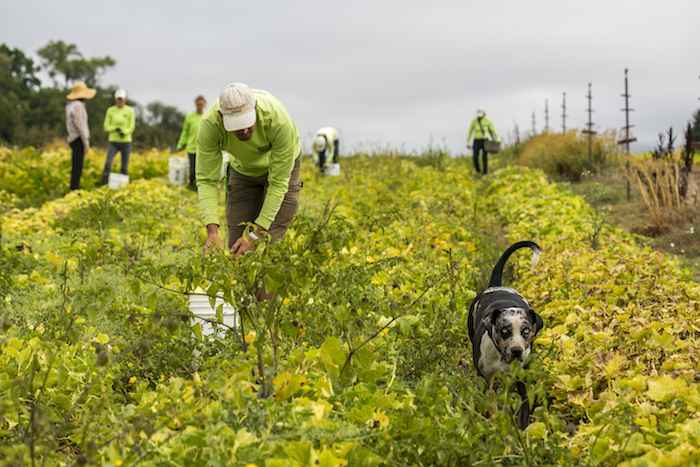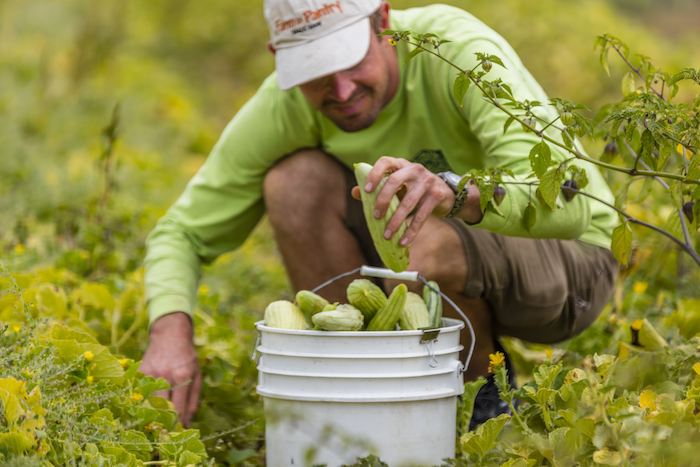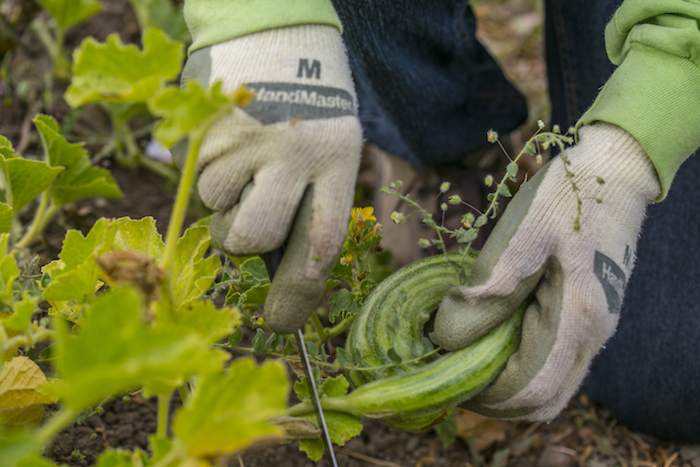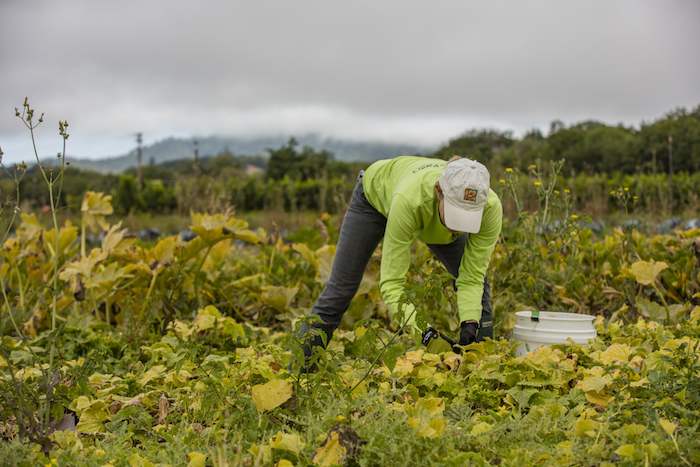Local gleaners save the harvest, just as they’ve done for thousands of years.
Food waste is a hot topic in 2015. According to a report by the National Resources Defense Council, 40 percent of the food in the United States goes uneaten. Americans throw out some $165 billion in food each year. This discarded sustenance is the largest single component of U.S. municipal solid waste. Instead of going into our stomachs, it ends up rotting in landfills and emitting large amounts of methane, a contributor to greenhouse gases.
Chefs like Blue Hill’s Dan Barber have been lauded for elevating discarded food into culinary art. But the original food waste heroes, the poor peasant women who went into the fields to glean wheat left behind by reapers, have been around since (almost) the beginning of time—or, at least, the written word.
“Gleaning is an old concept,” says Melita Love, founder of Farm to Pantry, a nonprofit gleaning organization based in Healdsburg. “I like to remind people that the early gleaner was Ruth. There’s nothing new under the sun. Luckily, gleaning is something that’s coming back.”
In ancient times, gleaning was considered a moral good, a welfare system for the poor and the hungry. In some European countries, it’s written into law as a citizen’s due, an attitude that filmmaker Agnes Varda explored in her fantastically weird and political 2000 documentary The Gleaners and I. In the U.S., where capitalism has elevated private property to a near-sacrament, gleaning isn’t nearly as common.
But, if you look carefully, you will see the gleaners. They’re on the banks of the Santa Rosa Creek, harvesting greens for a stir-fry. Underneath black walnut trees gathering the tenacious, brown-hulled nuts into sacks to be transported home and dried on racks. In abandoned orchards, picking apples and pears for pies and jellies. Although, in truth, these people are more accurately defined as guerilla gleaners; the true definition of a gleaner is one who comes in after the harvest, usually with legal or informal permission, to retrieve what has been left behind.
Since Farm to Pantry launched in 2008 with the gleaning of a fig tree, gleaning groups have popped up across Sonoma County. In addition to Farm to Pantry, we now have CropMobster, Petaluma Bounty, Slow Harvest, and the Sonoma Valley Gleaning Project.
“In the beginning, we would have to explain even what the word ‘gleaning’ meant, and now we don’t have to do that anymore,” says ceramicist Aletha Soulé, a coordinator with Slow Harvest, a group of 10 volunteers supported under the umbrella of Slow Food Sonoma County North. Everyone involved sees the benefits, Soulé adds. The farmer doesn’t have to pay someone to harvest produce that—thanks to consumer demand for perfect, unblemished produce—doesn’t meet strict market standards. The surplus can be distributed to clients and cooked into nutritious meals.
Slow Harvest volunteers glean from 300 to 1,000 pounds of produce a month from West County farms, including Earthworker, First Light, Munch Apples, New Family, and Quetzal. Since 2009, they’ve gleaned a total of 50,000 pounds. The resulting produce and fruit is donated to Ceres Community Project, Food For Thought Food Bank, the Graton Day Labor Center, Redwood Empire Food Bank, and the Redwood Gospel Mission. The group also coordinates cooking events, using Healdsburg’s Relish Culinary Center’s kitchen to cook up nutritional meals like spicy gazpacho and potato masala and white bean soup for delivery to local food banks.
“The thing that’s amazing to me is that we’ve gleaned that much without being a nonprofit organization with salaried positions,” says Soulé. “This is just a handful of friends. It’s such a wonderful model for people to spin off from and to create the type of glean project that works for them.”
There is one problem with the volunteer-driven model, as anyone who has run herself ragged trying to start a community movement knows: The high burnout rate. According to Melita Love, at least three gleaning groups around the county have started and then folded since 2008. That’s why, in hopes of making the group sustainable, she decided to turn Farm to Pantry into an official nonprofit. They qualified for 501c3 status this year, enabling the hire of Dani Wilcox as a part-time coordinator.
In Sonoma County, agriculture is an all-season affair. For that reason, gleaning groups have harvested thousands of pounds to be donated mainly to food pantries, after-school programs, homeless shelters, and other organizations that provide sustenance to the food insecure. Farm to Pantry has gleaned a total of about 98 tons of fruit and vegetables from farms and private land. They are on track to reach 100 tons after this year’s harvest. Summer brings apples and squash. Winter means citrus—lots and lots of citrus. “We gleaned 360 pounds of oranges from one tree, and 300 pounds of lemons from another,” says Love, still amazed at the abundance from two small trees.
On a hot Tuesday morning in late July, I join Love and three volunteers for a glean at Foggy River Farm, an organic family-owned farm on the outskirts of Healdsburg. In a long-sleeved neon green T-shirt, her blonde hair pulled up in a ponytail under a sun visor, Love looks energized and ready for action. We are here to glean zephyrs, romanesco, and patty pan squash. Emmett Hopkins, the farm’s young owner, shows us the exact sizes of the vegetables to be gleaned, and then sends us out to the field, trusting we’ll make the right choices. This is actually a pre-harvest glean, a way to clear away produce that will be too large and unwieldy to sell at Friday’s farmers’ market.
“Like everyone around here, we sometimes have crops on the plants that are still good even after we finish harvesting,” Hopkins says. “Either we didn’t have time to harvest it, or it wasn’t quite what we need. It’s nice to have it be used.” Another benefit to the farmer, he adds, is the savings in time and labor. Whatever is taken by the volunteers doesn’t have to be sorted through later, meaning he can focus on the produce that’ll actually earn money.
Out in the field, we repeatedly stoop down to harvest the squash. I’m reminded of Des glaneuses, the 1857 Jean-François Millet painting that depicts three French peasant women stooping to glean corn left by harvesters. Gleaning, it can be argued, is noble work. It’s also exhausting.
We finish and the yield is tallied: 73 pounds. Smaller than normal, says Love, but the white boxes laden with gleaming yellow and green organic squash still look like a bounty to the uninitiated. The squash will be combined with another 150 pounds gleaned across town in Alexander Valley, a yield that includes apples, Asian pears, bell peppers, beans, pears, and nectarines. If a pound of produce serves about four people, Love estimates that today’s work will potentially feed 892 people.
Each box is labeled with the glean location and date, a new requirement thanks to Assembly Bill 1990, California’s controversial new food safety law. When the law first passed in 2014, its strict requirements threatened to put a halt to gleaning. Love credits Supervisor James Gore for gathering stakeholders to find a solution that exempted gleaning groups from the well-meaning, but unintended consequences of the legislation. Currently under consideration with the California Senate, AB 234 could further restrict gleaning efforts.
On the ride back into town, I chat with Erik Anderson, a lanky and soft-spoken young man in a blue sunhat. He lives in Healdsburg with his grandmother on land that was once a kiwi orchard and is now, of course, a vineyard. Anderson, 33, has volunteered with Farm to Pantry for years, gleaning twice a week. In addition to squash, he’s gleaned apples, cabbage, cucumbers, potatoes, walnuts, persimmons, and . . . kiwi. Unemployed of late, Anderson qualifies for a free box of food from the Healdsburg Food Pantry. He sometimes has the pleasure of receiving back fruits and vegetables that he picked the previous week. Working with the gleaning group gives him both a sense of community and purpose, he says.
Farm “not-to-table” is what comedian and TV host John Oliver has called the U.S. food waste situation. Considering that in 2013, 49.1 million Americans lived in “food-insecure” households, that’s no joke. According to the Redwood Empire Food Bank, here in the farm-to-table capital of Sonoma County, 82,000 people face the threat of hunger every month—a number that includes 36,200 children. This is a crazy fact in a county where an abundance of fruits and vegetables can feel like a birthright. But for many people, it’s not.
Gleaners help the Healdsburg Food Pantry to offer as many as 350 families a week freshly harvested squash, apples, tomatoes, oranges, and cucumbers, along with the standard and processed goods, says Roger Dormire, president of Healdsburg Shared Ministries, which runs the pantry. It’s a necessary act, just as it’s been since the Book of Ruth.
“We couldn’t afford to buy all of these fresh, organic, fruits and vegetables,” he says. “We wouldn’t be able to get them without the gleaners.”




